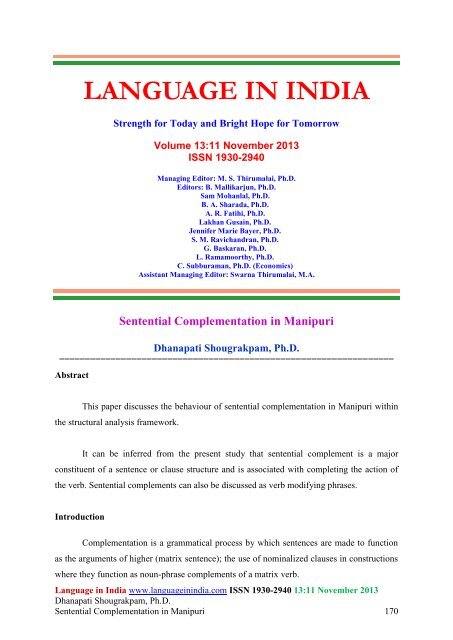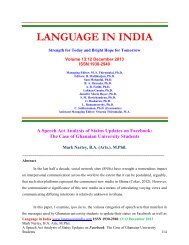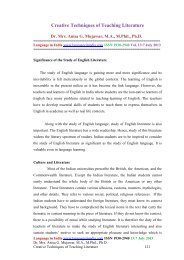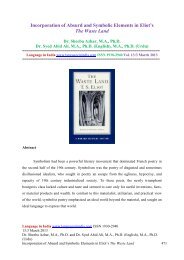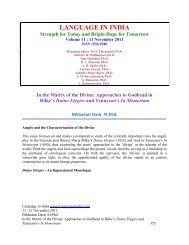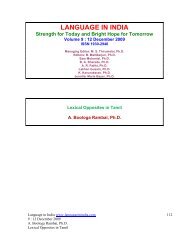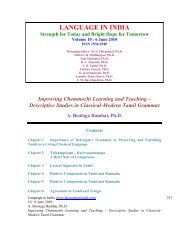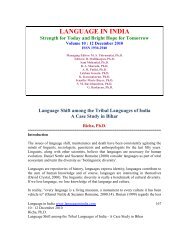This is only the beginning part of the article ... - Language in India
This is only the beginning part of the article ... - Language in India
This is only the beginning part of the article ... - Language in India
Create successful ePaper yourself
Turn your PDF publications into a flip-book with our unique Google optimized e-Paper software.
LANGUAGE IN INDIA<br />
Strength for Today and Bright Hope for Tomorrow<br />
Volume 13:11 November 2013<br />
ISSN 1930-2940<br />
Manag<strong>in</strong>g Editor: M. S. Thirumalai, Ph.D.<br />
Editors: B. Mallikarjun, Ph.D.<br />
Sam Mohanlal, Ph.D.<br />
B. A. Sharada, Ph.D.<br />
A. R. Fatihi, Ph.D.<br />
Lakhan Gusa<strong>in</strong>, Ph.D.<br />
Jennifer Marie Bayer, Ph.D.<br />
S. M. Ravichandran, Ph.D.<br />
G. Baskaran, Ph.D.<br />
L. Ramamoorthy, Ph.D.<br />
C. Subburaman, Ph.D. (Economics)<br />
Ass<strong>is</strong>tant Manag<strong>in</strong>g Editor: Swarna Thirumalai, M.A.<br />
Sentential Complementation <strong>in</strong> Manipuri<br />
Dhanapati Shougrakpam, Ph.D.<br />
=================================================================<br />
Abstract<br />
<strong>Th<strong>is</strong></strong> paper d<strong>is</strong>cusses <strong>the</strong> behaviour <strong>of</strong> sentential complementation <strong>in</strong> Manipuri with<strong>in</strong><br />
<strong>the</strong> structural analys<strong>is</strong> framework.<br />
It can be <strong>in</strong>ferred from <strong>the</strong> present study that sentential complement <strong>is</strong> a major<br />
constituent <strong>of</strong> a sentence or clause structure and <strong>is</strong> associated with complet<strong>in</strong>g <strong>the</strong> action <strong>of</strong><br />
<strong>the</strong> verb. Sentential complements can also be d<strong>is</strong>cussed as verb modify<strong>in</strong>g phrases.<br />
Introduction<br />
Complementation <strong>is</strong> a grammatical process by which sentences are made to function<br />
as <strong>the</strong> arguments <strong>of</strong> higher (matrix sentence); <strong>the</strong> use <strong>of</strong> nom<strong>in</strong>alized clauses <strong>in</strong> constructions<br />
where <strong>the</strong>y function as noun-phrase complements <strong>of</strong> a matrix verb.<br />
<strong>Language</strong> <strong>in</strong> <strong>India</strong> www.language<strong>in</strong><strong>in</strong>dia.com ISSN 1930-2940 13:11 November 2013<br />
Dhanapati Shougrakpam, Ph.D.<br />
Sentential Complementation <strong>in</strong> Manipuri 170
The <strong>only</strong> nom<strong>in</strong>aliz<strong>in</strong>g strategy <strong>in</strong> Manipuri <strong>is</strong> <strong>the</strong> pə ~ bə suffix.<br />
- ‘pə’ occurs after voiceless consonants.<br />
- ‘bə’ occurs after vowels and voiced consonants.<br />
All <strong>the</strong> action, process and stative roots are bound and known as verbal roots. They<br />
can be nom<strong>in</strong>alized by suffixation <strong>of</strong> <strong>the</strong> NZR - pə~bə, as <strong>in</strong> <strong>the</strong> follow<strong>in</strong>g two ways (i)<br />
addition to <strong>the</strong> direct verbal roots and (ii) after o<strong>the</strong>r suffix.<br />
Different Structures <strong>of</strong> Sentential Complementation Are D<strong>is</strong>cussed as Follows:<br />
(a) The way <strong>in</strong> which complement-tak<strong>in</strong>g predicates select nom<strong>in</strong>alized<br />
complements and <strong>the</strong> argument role <strong>of</strong> <strong>the</strong> complement can be drawn. There are<br />
<strong>in</strong>stances <strong>in</strong> which <strong>the</strong> nom<strong>in</strong>alized clause functions completely as a complement,<br />
with all <strong>of</strong> <strong>the</strong> arguments, be<strong>in</strong>g realized as <strong>in</strong>:<br />
1. nupa məca ədu ləp h oy cabə pam-mi<br />
man- small DET banana eat-NZR want-ASP<br />
The boy likes to eat banana.<br />
(b) A Nom<strong>in</strong>alized Complement Clause Functions as <strong>the</strong> Argument <strong>of</strong> <strong>the</strong><br />
Transitive Verb: Here, both <strong>of</strong> <strong>the</strong> arguments <strong>of</strong> <strong>the</strong> nom<strong>in</strong>alized complement clause<br />
reta<strong>in</strong> <strong>the</strong> case mark<strong>in</strong>g that <strong>the</strong>y would have <strong>in</strong> an <strong>in</strong>dependent f<strong>in</strong>ite clause. Thus, <strong>the</strong><br />
complement clause <strong>is</strong> be<strong>in</strong>g placed directly <strong>in</strong>to <strong>the</strong> NP slot without any adjustments<br />
to its structure outside <strong>of</strong> <strong>the</strong> nom<strong>in</strong>aliz<strong>in</strong>g suffix.<br />
Complementation <strong>of</strong> Transitive Verb uy ‘see’/tay ‘hear’:<br />
2. ma nə ma bu p h ubə əy uy<br />
he-NOM he-ACC beat-NZR I see<br />
I saw him beat<strong>in</strong>g him.<br />
3. ma nə ma bu cəybə əy tay<br />
he-NOM he-ACC scold-NZR I hear<br />
I heard him scold<strong>in</strong>g him.<br />
<strong>Language</strong> <strong>in</strong> <strong>India</strong> www.language<strong>in</strong><strong>in</strong>dia.com ISSN 1930-2940 13:11 November 2013<br />
Dhanapati Shougrakpam, Ph. D.<br />
Sentential Complementation <strong>in</strong> Manipuri 171
In <strong>the</strong> above two examples, <strong>the</strong>re <strong>is</strong> a clear <strong>in</strong>dication that one ‘him’ <strong>is</strong> <strong>the</strong> doer<br />
or subject [ma-nə (he-NOM)] and <strong>the</strong> o<strong>the</strong>r ‘him’ as <strong>in</strong> [ma-bu (he-ACC)] <strong>is</strong> <strong>the</strong><br />
object or recipient <strong>of</strong> <strong>the</strong> action.<br />
The structure can be more clearly seen as from <strong>the</strong> follow<strong>in</strong>g two examples-<br />
4. məpa nə ma bu phubə əy uy<br />
fa<strong>the</strong>r-NOM he-ACC beat-NZR I see<br />
I saw h<strong>is</strong> fa<strong>the</strong>r beat<strong>in</strong>g him.<br />
5. məpa nə ma bu caybə əy tay<br />
fa<strong>the</strong>r-NOM he-ACC scold-NZR I hear<br />
I heard h<strong>is</strong> fa<strong>the</strong>r scold<strong>in</strong>g him.<br />
(c)<br />
Complement Clause Constructions Involv<strong>in</strong>g Desiderative Predicate:<br />
Some complement clauses necessarily have adjustments to <strong>the</strong>ir <strong>in</strong>ternal<br />
syntactic structure when <strong>the</strong>y are embedded as arguments <strong>of</strong> a matrix verb.<br />
<strong>Th<strong>is</strong></strong> occurs when <strong>the</strong>re <strong>is</strong> co-reference between <strong>the</strong> matrix subject and <strong>the</strong><br />
complement subject.<br />
In <strong>the</strong> complement construction <strong>in</strong>volv<strong>in</strong>g desiderative predicate <strong>the</strong> subject <strong>of</strong><br />
<strong>the</strong> matrix verb and <strong>the</strong> subject <strong>of</strong> <strong>the</strong> complement verb are necessarily co-referential,<br />
and <strong>the</strong> subject <strong>of</strong> <strong>the</strong> complement verb <strong>is</strong> obligatorily unexpressed.<br />
6. əy yensa cabə pam-mi<br />
I chicken eat-NZR want-ASP<br />
I want to eat chicken.<br />
7. əy <strong>is</strong>əy səkpə pam-jəy<br />
I song s<strong>in</strong>g-NZR want-ASP<br />
I like s<strong>in</strong>g<strong>in</strong>g.<br />
(d)<br />
The Evidence for Indication <strong>of</strong> More General Nom<strong>in</strong>aliz<strong>in</strong>g Strategy <strong>in</strong><br />
Embedd<strong>in</strong>g Sentential Complements - A grammatical process which <strong>in</strong>volves <strong>the</strong><br />
<strong>Language</strong> <strong>in</strong> <strong>India</strong> www.language<strong>in</strong><strong>in</strong>dia.com ISSN 1930-2940 13:11 November 2013<br />
Dhanapati Shougrakpam, Ph. D.<br />
Sentential Complementation <strong>in</strong> Manipuri 172
objectification <strong>of</strong> a complete sentential proposition such that it may occupy <strong>the</strong><br />
functional slot <strong>of</strong> a noun phrase with<strong>in</strong> a larger sentence.<br />
8. nupa ləp h oy cabə du əy gi imanəbə ni<br />
man banana eat-NZR DET I-GEN friend-COP<br />
The boy who ate banana <strong>is</strong> my friend.<br />
9. nupi du kibə dəgi pəysa du tombə də pi<br />
womanDET afraid-NZR-CAUS money DET TombaEMP give<br />
The woman gave <strong>the</strong> money to Tomba out <strong>of</strong> fear.<br />
(Someone) Gave <strong>the</strong> money to Tomba for fear <strong>of</strong> <strong>the</strong> woman.<br />
(e)<br />
In Complementation by Nom<strong>in</strong>alization, <strong>the</strong> nom<strong>in</strong>alizer pə~bə <strong>is</strong> suffixed<br />
to <strong>the</strong> predicate <strong>of</strong> <strong>the</strong> sub-ord<strong>in</strong>ate clause as shown below –<br />
10. nupa məca ədu ləp h oy cabə pam-mi<br />
man small DET banana eat-NZR want-ASP<br />
The boy likes to eat banana.<br />
11. nupi məca ədu koybə cətpə pam-mi<br />
woman small DET roam go-NZR want-ASP<br />
The girl likes roam<strong>in</strong>g.<br />
(f)<br />
Sentential Complements are also embedded by means <strong>of</strong> <strong>the</strong> attributive<br />
subord<strong>in</strong>ator–compare (1) and (2) below:<br />
12. samu t h aŋ nə hatpə du yamnə nuŋŋay-te<br />
elephant knife-INST kill-NZR DET QTF happy-NEG<br />
The kill<strong>in</strong>g <strong>of</strong> <strong>the</strong> elephant with a knife <strong>is</strong> very sadden<strong>in</strong>g.<br />
13. manipuri lon ŋaŋbə yamnə luy<br />
Manipuri language speak-NZR QTF difficult<br />
Speak<strong>in</strong>g Manipuri language <strong>is</strong> very difficult.<br />
<strong>Language</strong> <strong>in</strong> <strong>India</strong> www.language<strong>in</strong><strong>in</strong>dia.com ISSN 1930-2940 13:11 November 2013<br />
Dhanapati Shougrakpam, Ph. D.<br />
Sentential Complementation <strong>in</strong> Manipuri 173
In examples (12) and (13), <strong>the</strong> nom<strong>in</strong>alized sentential complement functions<br />
as grammatical subject <strong>of</strong> <strong>the</strong> matrix clause. There <strong>is</strong> no tense/aspect mark<strong>in</strong>g <strong>in</strong> <strong>the</strong><br />
matrix clause. A d<strong>is</strong>t<strong>in</strong>ction between realized and unrealized sentential complements<br />
can be drawn as below:<br />
• The <strong>only</strong> <strong>in</strong>dicator that <strong>the</strong> situation described <strong>in</strong> <strong>the</strong> embedd<strong>in</strong>g <strong>in</strong> (12) <strong>is</strong><br />
realized <strong>in</strong> past time i.e. (kənagumbə əmənə) samu hatpə du ‘someone kill<strong>in</strong>g<br />
<strong>the</strong> elephant’ <strong>is</strong> <strong>the</strong> presence <strong>of</strong> <strong>the</strong> determ<strong>in</strong>er ‘du’.<br />
• The embedd<strong>in</strong>g <strong>in</strong> (13) <strong>is</strong> generic, it <strong>is</strong> unrealized <strong>in</strong> any specific <strong>in</strong>stance i.e.<br />
(kənagumbə əmənə) manipuri ŋaŋbə ‘somebody speak<strong>in</strong>g Manipuri’<br />
(g) The Difference Between Realized and Unrealized Sentential Complements<br />
can be seen <strong>in</strong> <strong>the</strong> follow<strong>in</strong>g pairs:<br />
The unrealized sentential complements assert a statement <strong>in</strong> each <strong>of</strong> <strong>the</strong> first<br />
pair (as <strong>in</strong> a).<br />
The realized sentential complements (as <strong>in</strong> b) are d<strong>is</strong>t<strong>in</strong>gu<strong>is</strong>hed formally from<br />
unrealized sentential complement by <strong>the</strong> presence <strong>of</strong> <strong>the</strong> case markers after <strong>the</strong><br />
nom<strong>in</strong>alized verb. The presence <strong>of</strong> <strong>the</strong> case marker <strong>in</strong>dicates that <strong>the</strong> embedd<strong>in</strong>g <strong>is</strong> a<br />
realized one and shows <strong>the</strong> direct connection <strong>of</strong> <strong>the</strong> subord<strong>in</strong>ate clause with <strong>the</strong> matrix<br />
clause.<br />
It <strong>is</strong> obvious that <strong>the</strong> matrix clause <strong>is</strong> a result <strong>of</strong> <strong>the</strong> embedded clause. The<br />
notion <strong>of</strong> realized situations <strong>is</strong> specifiable <strong>in</strong> that <strong>the</strong>y are temporally bounded, onetime<br />
occurrences.<br />
14. a. cak yamnə cabə noy<br />
rice QTF eat-NZR fat<br />
Eat<strong>in</strong>g too much rice makes one fat.<br />
14. b. əy cak yamnə cabə dəgi noy-re<br />
I rice QTF eat-NZR-CAUS fat-ASP<br />
I am fat because <strong>of</strong> eat<strong>in</strong>g too much rice.<br />
<strong>Language</strong> <strong>in</strong> <strong>India</strong> www.language<strong>in</strong><strong>in</strong>dia.com ISSN 1930-2940 13:11 November 2013<br />
Dhanapati Shougrakpam, Ph. D.<br />
Sentential Complementation <strong>in</strong> Manipuri 174
15. a. əy t h əbək yamnə təwbə way<br />
I work QTF do-NZR tired<br />
Do<strong>in</strong>g too much work makes me tired.<br />
15. b. əy t h əbək yamnə təwbə dəgi wa-re<br />
I work QTF do-NZR-CAUS tired-ASP<br />
I am tired <strong>of</strong> do<strong>in</strong>g too much work.<br />
(h)<br />
Purpose and Result Embedd<strong>in</strong>gs <strong>in</strong> Sentential Complements:<br />
(1) The purpose embedd<strong>in</strong>gs are <strong>in</strong>stance <strong>of</strong> an unrealized event, an action that <strong>is</strong><br />
not completed as yet. It <strong>is</strong> <strong>in</strong>dicated by <strong>the</strong> future aspect marker kəni~gəni as shown <strong>in</strong><br />
each <strong>of</strong> <strong>the</strong> first pair (as <strong>in</strong> a).<br />
(2) The result embedd<strong>in</strong>gs are <strong>in</strong>stance <strong>of</strong> a realized event, that <strong>is</strong>, <strong>the</strong> action <strong>is</strong><br />
completed from an aspectual view. It <strong>is</strong> <strong>in</strong>dicated by <strong>the</strong> presence <strong>of</strong> <strong>the</strong> causative<br />
markers ‘dəgi’ which <strong>is</strong> added to <strong>the</strong> nom<strong>in</strong>alized verbal root as shown <strong>in</strong> each <strong>of</strong> <strong>the</strong><br />
second pair (as <strong>in</strong> b). The notion <strong>of</strong> realized situations are specifiable <strong>in</strong> that <strong>the</strong>y are<br />
temporarily bounded, one time occurrence.<br />
16. a. məhak yen cabə lak-kəni<br />
he chicken eat-NZR come-ASP<br />
He will come to eat chicken.<br />
16. b. məhak yen cabə dəgi na-re<br />
he chicken eat-NZR-CAUS sick-ASP<br />
He has fallen sick from eat<strong>in</strong>g chicken.<br />
17. a. məhak layrik pabə lak-kəni<br />
he book read-NZR come-ASP<br />
He will come to study.<br />
17. b. məhak layrik yamnə pabə dəgi wa-re<br />
he book QTF read-NZR-CAUS tired-ASP<br />
Read<strong>in</strong>g too much made him tired.<br />
<strong>Language</strong> <strong>in</strong> <strong>India</strong> www.language<strong>in</strong><strong>in</strong>dia.com ISSN 1930-2940 13:11 November 2013<br />
Dhanapati Shougrakpam, Ph. D.<br />
Sentential Complementation <strong>in</strong> Manipuri 175
18. a. məhak yu t h əkpə cət-kəni<br />
he w<strong>in</strong>e dr<strong>in</strong>k-NZR go-ASP<br />
He will go for dr<strong>in</strong>k<strong>in</strong>g.<br />
18. b. məhak yu t h əkpə dəgi ŋaw-re<br />
he w<strong>in</strong>e dr<strong>in</strong>k-NZR-CAUS mad-ASP<br />
He <strong>is</strong> high from dr<strong>in</strong>k<strong>in</strong>g.<br />
The causative markers ‘də’ and ‘gi’ can also be added to <strong>the</strong> nom<strong>in</strong>alized<br />
verbal root <strong>in</strong> each <strong>of</strong> <strong>the</strong> second pair (b) above as shown below<br />
19. məhak yen cabə də na-re<br />
he chicken eat-NZR-CAUS sick-ASP<br />
He fell sick from eat<strong>in</strong>g chicken.<br />
20. məhak yen cabə gi na-re<br />
he chicken eat-NZR-CAUS sick-ASP<br />
He fell sick because <strong>of</strong> eat<strong>in</strong>g chicken.<br />
(i)<br />
The Sentential Complement Can Precede, Follow or Be Embedded <strong>in</strong>to<br />
<strong>the</strong> matrix clause:<br />
i) The sentential complement [ran<strong>in</strong>ə əŋaŋbə məcu pambə] precedes <strong>the</strong><br />
matrix clause [əy khəŋŋi] as <strong>in</strong><br />
21. [ran<strong>in</strong>ə əŋaŋbə məcu pambə] əy khəŋŋi<br />
Rani-NOM red color want-NZR I know<br />
I know that Rani likes red color.<br />
ii)<br />
The sentential complement [rani nə əŋaŋbə məcu pambə] can follow <strong>the</strong><br />
matrix clause [əy khəŋŋi] as shown below<br />
22. əy khəŋŋi [rani nə əŋaŋbə məcu pambə]<br />
I know Rani-NOM red color want-NZR<br />
I know that Rani likes red color.<br />
The use <strong>of</strong> th<strong>is</strong> k<strong>in</strong>d <strong>of</strong> sentential complement <strong>is</strong> less frequent.<br />
<strong>Language</strong> <strong>in</strong> <strong>India</strong> www.language<strong>in</strong><strong>in</strong>dia.com ISSN 1930-2940 13:11 November 2013<br />
Dhanapati Shougrakpam, Ph. D.<br />
Sentential Complementation <strong>in</strong> Manipuri 176
iii)<br />
The sentential complement [rani nə əŋaŋbə məcu pambə] can be embedded<br />
<strong>in</strong>to <strong>the</strong> matrix clause [ əy khəŋŋi] as shown below<br />
23. əy [rani nə əŋaŋbə məcu pambə] khəŋŋi<br />
I Rani-NOM red color want-NZR know<br />
I know that Rani likes red color.<br />
(j) There are two ma<strong>in</strong> types <strong>of</strong> quotative complementizers, namely ‘haybә’<br />
and ‘haynә’; <strong>the</strong>se two complementizers have been derived from <strong>the</strong> verb hay ‘say’<br />
through <strong>the</strong> addition <strong>of</strong> <strong>the</strong> adverbial suffix ‘-nə’ and <strong>the</strong> <strong>in</strong>f<strong>in</strong>itive suffix ‘-bə’<br />
respectively.<br />
Complements end<strong>in</strong>g <strong>in</strong> ‘haybə’ refer to a fact (a state, process or action)<br />
whereas <strong>the</strong> ones end<strong>in</strong>g <strong>in</strong> ‘haynə’ refer to a statement. The use <strong>of</strong> <strong>the</strong>se<br />
complementizers <strong>in</strong>volves certa<strong>in</strong> pre-suppositional differences.<br />
(I)<br />
Complementation by <strong>the</strong> Use <strong>of</strong> <strong>the</strong> Quotative Complementizer ‘haybә’:<br />
The more general nom<strong>in</strong>alizer which corresponds more closely to <strong>the</strong> relative<br />
clause nom<strong>in</strong>alization <strong>is</strong> a fully <strong>in</strong>flected f<strong>in</strong>ite clause nom<strong>in</strong>alization by <strong>the</strong> quotative<br />
complementizer ‘haybə’. The quotative turns <strong>the</strong> entire clause <strong>in</strong>to an attribute, which<br />
<strong>the</strong>n can be used to make reference to ei<strong>the</strong>r <strong>the</strong> subject or <strong>the</strong> object (depend<strong>in</strong>g on<br />
which argument <strong>is</strong> made <strong>the</strong> head <strong>of</strong> <strong>the</strong> noun phrase).<br />
24. cawbə nə cawbi pamjəy haybə əy k h əŋŋi<br />
Chaoba-NOM Chaobi like QTV I know<br />
I know that Chaoba likes Chaobi.<br />
25. əy ca kərəmnə sem-gəni haybə k h əŋŋi<br />
I tea how make-ASP QTV know<br />
I know how to make tea.<br />
26. məhak kərəmnə tusəl-li haybə əy k h əŋŋi<br />
he how to fall -ASP QTV I know<br />
I know how he fell down.<br />
<strong>Language</strong> <strong>in</strong> <strong>India</strong> www.language<strong>in</strong><strong>in</strong>dia.com ISSN 1930-2940 13:11 November 2013<br />
Dhanapati Shougrakpam, Ph. D.<br />
Sentential Complementation <strong>in</strong> Manipuri 177
The Quotative ‘haybә’ <strong>is</strong> Used to Infer an Assertion:<br />
(i) When speaker d<strong>is</strong>agrees or wants to <strong>in</strong>tentionally challenge an earlier<br />
statement made by someone else as <strong>in</strong> <strong>the</strong> follow<strong>in</strong>g examples.<br />
27. ma nə məp h əm ədu p h əjəy haybə əranbə-ni<br />
he-NOM place DET nice QTV wrong-COP<br />
H<strong>is</strong> say<strong>in</strong>g that <strong>the</strong> place <strong>is</strong> nice <strong>is</strong> wrong.<br />
28. ma nə deli də təm-mi haybə təws<strong>in</strong>nəbə-ni<br />
he-NOM Delhi-LOC study-ASP QTV deceit-COP<br />
H<strong>is</strong> say<strong>in</strong>g that he studies <strong>in</strong> Delhi <strong>is</strong> a deceit.<br />
(ii)<br />
When speaker wants to show agreement to an earlier statement made by<br />
someone else as <strong>in</strong> <strong>the</strong> follow<strong>in</strong>g examples.<br />
29. ma nə məp h əm ədu p h əjəy haybə əcumbə-ni<br />
he-NOM place DET nice QTV true-COP<br />
H<strong>is</strong> say<strong>in</strong>g that <strong>the</strong> place <strong>is</strong> nice <strong>is</strong> true.<br />
30. ma nə deli də təm-mi haybə əseŋbə-ni<br />
he-NOM Delhi-LOC study-ASP QTV truth-COP<br />
H<strong>is</strong> say<strong>in</strong>g that he studies <strong>in</strong> Delhi <strong>is</strong> a truth.<br />
(iii)<br />
The agreement to a statement can be <strong>in</strong>dicated by <strong>the</strong> addition <strong>of</strong> <strong>the</strong> lexical<br />
negator ‘nətte’ to <strong>the</strong> negative words as <strong>in</strong> <strong>the</strong> follow<strong>in</strong>g examples.<br />
31. ma nə deli də təmmi haybə əranbə nətte<br />
he-NOM Delhi-LOC study-ASP QTV false-LNTR<br />
H<strong>is</strong> say<strong>in</strong>g that he studies <strong>in</strong> Delhi <strong>is</strong> a truth.<br />
32. ma nə məpa doktər ni haybə məc<strong>in</strong> t h ibə nətte<br />
he-NOM fa<strong>the</strong>r doctor-COP QTV lips lie-LNTR<br />
H<strong>is</strong> say<strong>in</strong>g that h<strong>is</strong> fa<strong>the</strong>r <strong>is</strong> a doctor <strong>is</strong> not a lie.<br />
<strong>Language</strong> <strong>in</strong> <strong>India</strong> www.language<strong>in</strong><strong>in</strong>dia.com ISSN 1930-2940 13:11 November 2013<br />
Dhanapati Shougrakpam, Ph. D.<br />
Sentential Complementation <strong>in</strong> Manipuri 178
The quotative complimentizer ‘haybә’ <strong>is</strong> used for show<strong>in</strong>g <strong>of</strong>f one’s ability when<br />
used with <strong>the</strong> emphatic marker ‘di’ as <strong>in</strong> <strong>the</strong> follow<strong>in</strong>g examples.<br />
33. əy di sari kərəmnə set-kəni haybə k h əŋŋi<br />
I- EMP saree how wear-ASP QTV know<br />
I know how to wear a saree.<br />
34. əy di yen kərəmnə t h oŋ-gəni haybə k h əŋŋi<br />
I EMP hen how cook-ASP QTV know<br />
I know how to cook chicken.<br />
(II)<br />
Use <strong>of</strong> <strong>the</strong> Quotative Complimentizer ‘haynә’:<br />
The use <strong>of</strong> <strong>the</strong> quotative complimentizer ‘haynə’ refer to a statement as shown<br />
<strong>in</strong> <strong>the</strong> follow<strong>in</strong>g examples.<br />
35. əy cət-kəni haynə wasək-k h i<br />
I go-ASP QTV prom<strong>is</strong>e-ASP<br />
I prom<strong>is</strong>ed that I would be go<strong>in</strong>g.<br />
36. cawbə nə cawbi pamjəy haynə hay<br />
Chaoba-NOM Chaobi like QTV say<br />
Chaoba says that he likes Chaobi.<br />
37. mə yen kərəmnə t h oŋ-gəni k h aŋŋi haynə hay<br />
he chicken how cook-ASP know QTV say<br />
He says he knows how to make chicken.<br />
(III)<br />
Alternate Use <strong>of</strong> Quotative Complimentizer ‘haybә’ and ‘haynә’:<br />
38. əy ŋa cabə pam-mi haynə mək h oy də k h əŋhən-k h i<br />
I f<strong>is</strong>h eat-NZR want-ASP QTV <strong>the</strong>y-EMP let know -ASP<br />
I made <strong>the</strong>m know that I want to eat f<strong>is</strong>h.<br />
<strong>Language</strong> <strong>in</strong> <strong>India</strong> www.language<strong>in</strong><strong>in</strong>dia.com ISSN 1930-2940 13:11 November 2013<br />
Dhanapati Shougrakpam, Ph. D.<br />
Sentential Complementation <strong>in</strong> Manipuri 179
39. əy ŋa cabə pam-mi haybə mək h oy də k h əŋhən-k h i<br />
I f<strong>is</strong>h eat-NZR want-ASP QTV <strong>the</strong>y-EMP let know-ASP<br />
I made <strong>the</strong>m know that I want to eat f<strong>is</strong>h.<br />
(IV)<br />
Statement:<br />
Use <strong>of</strong> Quotative Complimentizer ‘haybә’ and ‘haynә’ <strong>in</strong> a S<strong>in</strong>gle<br />
The two complementizers can be used <strong>in</strong> a s<strong>in</strong>gle embedd<strong>in</strong>g when assert<strong>in</strong>g a<br />
statement on behalf <strong>of</strong> someone else absence. In such a case, it <strong>is</strong> obligatory that <strong>the</strong><br />
quotative complementizer‘haynə’ can <strong>only</strong> precede <strong>the</strong> quotative complementizer<br />
‘haybə’ as shown below.<br />
40. ma p h urit ədu pam-mi haynə haybə əy k h əŋŋi<br />
he shirt DET want-ASP QTV QTV I know<br />
I know that he says that he likes <strong>the</strong> shirt.<br />
41. ma deli də cət-kəni haynə haybə əy k h əŋŋi<br />
he delhi-LOC go-ASP QTV QTV I know<br />
I know that he says that he would go to Delhi.<br />
42. ma ca t h ək-kəni haynə haybə ni<br />
he tea dr<strong>in</strong>k-ASP QTV QTV-COP<br />
He says that he would dr<strong>in</strong>k tea.<br />
43. ma lak-kəni haynə haybə ni<br />
he come-ASP QTV QTV-COP<br />
He says that he would come.<br />
44. ma cətpə yawni haynə haybə ni<br />
he go-NZR jo<strong>in</strong> QTV QTV COP<br />
He says that he would be go<strong>in</strong>g along.<br />
<strong>Language</strong> <strong>in</strong> <strong>India</strong> www.language<strong>in</strong><strong>in</strong>dia.com ISSN 1930-2940 13:11 November 2013<br />
Dhanapati Shougrakpam, Ph. D.<br />
Sentential Complementation <strong>in</strong> Manipuri 180
45. ma ca-gəni haynə haybə ni<br />
he eat-ASP QTV QTV-COP<br />
He says that he would eat.<br />
Conclusion<br />
<strong>Th<strong>is</strong></strong> paper <strong>is</strong> essentially an exploratory analys<strong>is</strong> <strong>of</strong> Sentential Complementation <strong>in</strong><br />
Manipuri. These prelim<strong>in</strong>ary f<strong>in</strong>d<strong>in</strong>gs will hopefully serve as a bas<strong>is</strong> for advancement <strong>of</strong><br />
fur<strong>the</strong>r studies.<br />
=================================================================<br />
Abbreviations<br />
ACC : Accusative<br />
ASP : Aspect<br />
COP : Copula<br />
CAUS: Causative<br />
DET : Determ<strong>in</strong>er<br />
EMP : Emphatic<br />
GEN : Genitive<br />
INST : Instrumental<br />
LOC : Locative<br />
LNTR : Lexical Negator<br />
NEG : Negative<br />
NOM : Nom<strong>in</strong>ative<br />
NZR : Nom<strong>in</strong>alizer<br />
QTF : Quantifier<br />
QTV : Quotative<br />
=============================================================<br />
References<br />
Yashwanta Ch. (2000) ‘Manipuri Grammar’, Rajesh Publication, New Delhi.<br />
Chomsky, Noam (1970). ‘Remarks on nom<strong>in</strong>alizations. In Roderick A. Jacobs and<br />
peters. Rosenbaum (eds).<br />
<strong>Language</strong> <strong>in</strong> <strong>India</strong> www.language<strong>in</strong><strong>in</strong>dia.com ISSN 1930-2940 13:11 November 2013<br />
Dhanapati Shougrakpam, Ph. D.<br />
Sentential Complementation <strong>in</strong> Manipuri 181
Crystal, David (1985) ‘A First dictionary <strong>of</strong> L<strong>in</strong>gu<strong>is</strong>tics and Phonetics.’ Service<br />
Book Syndicate, New Delhi.<br />
=============================================================<br />
Dhanapati Shougrakpam, Ph. D.<br />
De<strong>part</strong>ment <strong>of</strong> L<strong>in</strong>gu<strong>is</strong>tics<br />
Manipur University<br />
Canchipur<br />
Imphal – 795 003<br />
Manipur<br />
<strong>India</strong><br />
dippi1117@yahoo.co.<strong>in</strong><br />
<strong>Language</strong> <strong>in</strong> <strong>India</strong> www.language<strong>in</strong><strong>in</strong>dia.com ISSN 1930-2940 13:11 November 2013<br />
Dhanapati Shougrakpam, Ph. D.<br />
Sentential Complementation <strong>in</strong> Manipuri 182


